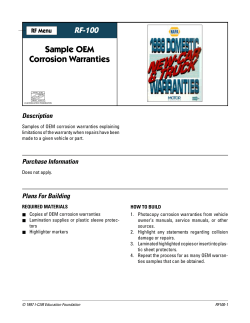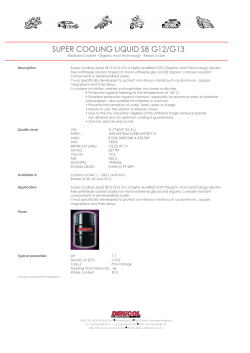
shipwrecks - corrosion at depthsx - slider-chemistry-12
1 Corrosion at great depths The wreck of the Titanic was found in 4000m deep waters Ship wrecks at great depths are corroded by electrochemical reactions and by anaerobic bacteria 2 Corrosion at great depths Sufficient light for plant growth does not occur below 200m Dead organisms provide nutrients for deep-dwelling animals and micro-organisms Thermal vents from ocean floor release sulphur rich water Ocean floor 4oC Intense pressure reduces O2 concentration (0.2ppb) Anaerobic condition prevail at this depth 3 Corrosion at great depths Some parts of the Titanic had long red hanging rusticles (rust-like / icicle-like) Other parts had black iron (II) sulfide Sulfate reducing bacteria (SRB) were important in forming the red rusticles and black FeS 4 Corrosion at great depths Bacteria associated with the rusticles are called "ironeating bacteria“ Two types of bacteria are found with the rusticles: -Anaerobic SRB which do not need oxygen are found on the inside -Oxygen dependent aerobic bacteria are found on the outside of the rusticles Chemical reactions carried out by this combination of bacteria increased the rate of corrosion of the iron in the Titanic 5 Corrosion at great depths Sea water normally has a pH 8 (almost all seawater cations are from strong bases (Na, K, Mg) But the increased solubility of CO2 with depth makes deep ocean water slightly acidic Carbon dioxide as bicarbonate Carbon dioxide binds loosely with water to form bicarbonate: CO2 + H2O <=> H2CO3 <=> H+ + HCO3<=> H+ + H+ + CO326 Corrosion at great depths As the pH drops with depth in ocean water the presence of more hydrogen ions favours corrosion of metals Corrosion of metals with acid produces metal ions: Fe + 2H+ --> Fe2+ + H2 Some metal ions produced can undergo hydrolysis (reaction with water) to produce even more hydrogen ions 7 Corrosion at great depths Describe the action of sulfate reducing bacteria (SRB) around deep wrecks Corrosion of metals with acid produces metal ions: Fe + 2H+ --> Fe2+ + H2 The SRB are able to change the H2 to 2H+ which they then use to reduce sulfate ions to hydrogen sulfide (H2S) SRB produce hydrogen sulfide from the sulfate ions that are plentiful in sea water: SO42– + 10H+ + 8e– --> H2S + 4H2O 8 Corrosion at great depths Note that the oxidation state of sulfur has been reduced from: +6 in SO42– to –2 in H2S This is why the anaerobic bacteria that cause this change are called sulfate reducing bacteria (SRB) 9 Corrosion at great depths Hydrogen ions can produce small acidic environments as low as pH 4 in some locations around a shipwreck H2S produced by the action of SRB is a weak acid that releases hydrogen ions and sulfide ions: H2S 2H+ + S2– H2S produced by sulfate reducing bacteria can react with just about any metal except gold and silver 10 Corrosion at great depths The sulfide ions from the H2S can precipitate Fe2+ ions to form insoluble black iron (II) sulfide FeS: Fe2+ + S2– --> FeS(s) The presence of black FeS indicates that SRB are present The precipitation of FeS removes sulfide ions and encourages further ionisation of H2S releasing more H+ 11 Corrosion at great depths Metal near wood on the Titanic was badly corroded As the wood cellulose (C6H10O5)n decayed it released oxygen which stimulated the growth of aerobic bacteria Waste from these aerobic bacteria provided nourishment to the anaerobic SRB Hence the SRB flourished and increased corrosion of metal near wood 12 Corrosion at great depths Acidic environments accelerate corrosion in nonpassivating metals Acidic conditions lead to an acceleration of the corrosion process compared with basic or neutral conditions Hydrogen ions can react with non-passivating metals, such as iron. Fe(s) + 2H+ --> Fe2+ + H2(g) 13 Corrosion at great depths Account for the differences in corrosion of active and passivating metals Corrosion is the oxidation of metal in the presence of oxygen, water, and an electrolyte Non-passivating (active) metals such as iron continues to corrode because rust is a porous compound that allows oxygen and water to reach the fresh layers of iron below 14 Corrosion at great depths Passivation is the spontanious process of making a material "passive" by the deposition of an oxide layer a few nanometers thick that adheres to the metals surface and inhibits further corrosion Metals with protective passivation layers include aluminium, chromium, titanium, and tin Non-passivating metals such as iron do not have a protective oxide layer that would prevent hydrogen ions reacting with metal atoms 15 Corrosion at great depths Rust is formed when iron compounds corrode in the presence of water and oxygen to form a mixture of iron oxides and hydroxides Iron is found naturally as iron oxide and purified iron quickly returns to a similar state when exposed to air and water 16 Corrosion at great depths This corrosion is due to the oxidation of a metal being an energetically favourable process: rust formation is exothermic The process of rusting can be summarised as three basic stages: -The formation of iron (II) ions from the metal -The formation of hydroxide ions -Their reaction together with the addition of oxygen to create rust 17 Corrosion at great depths The formation of iron (II) ions from the metal When an iron compound comes in to contact with a drop of water an electrochemical process starts On the surface of the metal iron is oxidised to iron (II): Fe -> Fe2+ + 2e- 18 Corrosion at great depths The formation of hydroxide ions The electrons released travel to the edges of the water droplet where there is plenty of dissolved oxygen. They reduce the oxygen and water to hydroxide ions: 2e- + 1/2O2 + H2O -> OH19 Corrosion at great depths Their reaction together with the addition of oxygen to create rust The hydroxide ions react with the iron (II) ions and more dissolved oxygen to form iron oxide. The hydration is variable (with x water molecules surrounding each iron oxide molecule): Fe2+ + 2OH- -> Fe2O3.xH2O 20 Corrosion at great depths Conclusion Rusting tends to happen faster in deep sea Ship wrecks at great depths are corroded due to factors such as: pH, temperature, sulfur compounds, anaerobic bacteria, electrochemical reactions 21 Questions 1. How is a passivating metal protected from corrosion 2. Using equations explain how corrosion in a non-passivating metal such as iron is accelerated in an acidic medium 3. Identify if seawater is acidic or basic 4. Account for the presence of anaerobic bacteria at great depths in the ocean 22 Questions 5. Compare the role of electrochemical cells and anaerobic bacteria at great depths in the ocean 6. By using oxidation numbers demonstrate the reduction of sulfate ions to sulfide ions as utilised by anaerobic bacteria 7. Construct an equation to show the reduction of sulfate ions to form hydrogen sulfide and water by anaerobic bacteria 23 Questions 8. By using equations describe how the iron in shipwrecks can react with hydrogen sulfide produced by anaerobic bacteria and water to produce an acid environment and iron hydroxide 9. Write an equation representing the effect of the acid microenvironment on corrosion 10. Outline how the above equation can account for the observation of corrosion found at the site of shipwrecks at depth 24
© Copyright 2025









